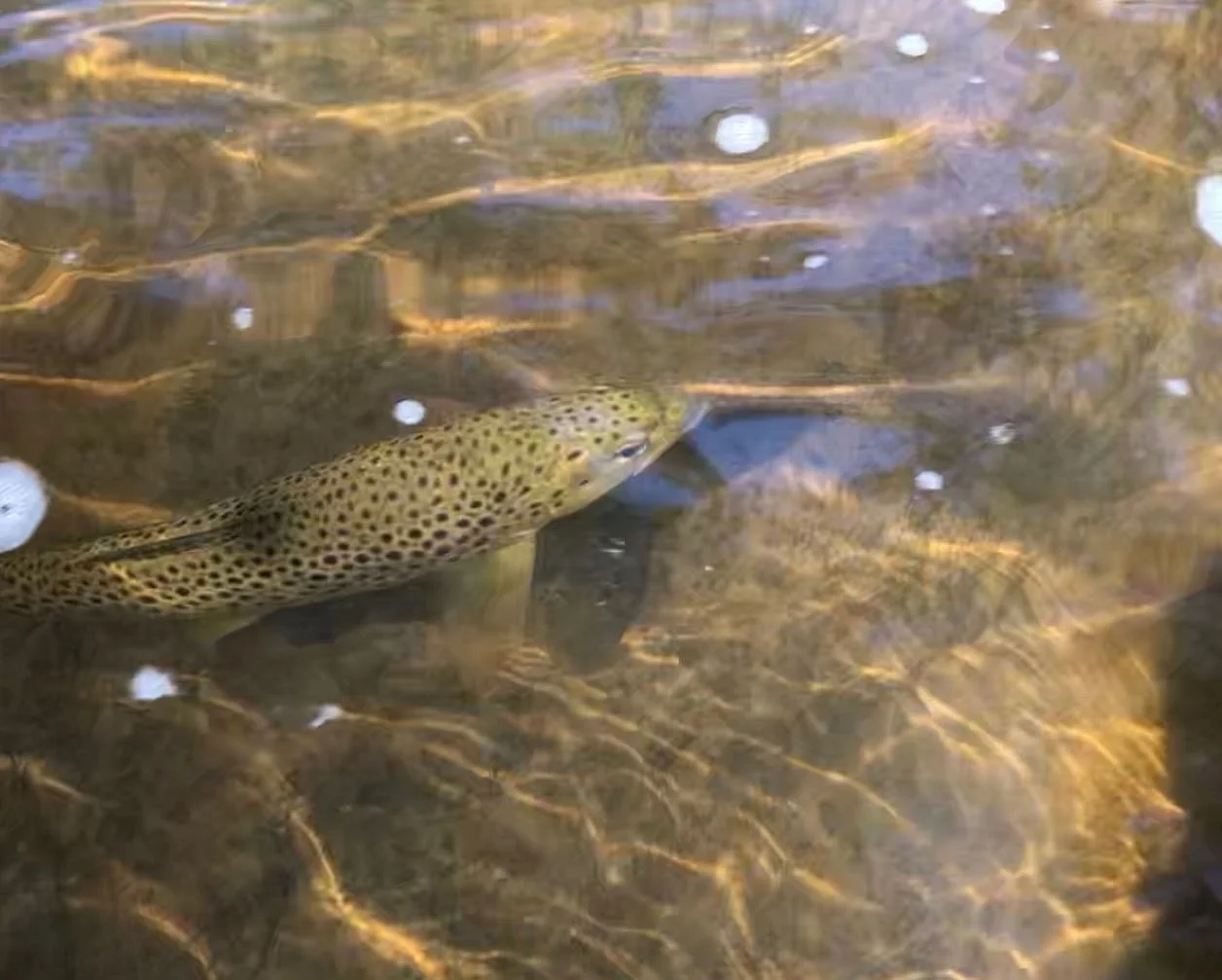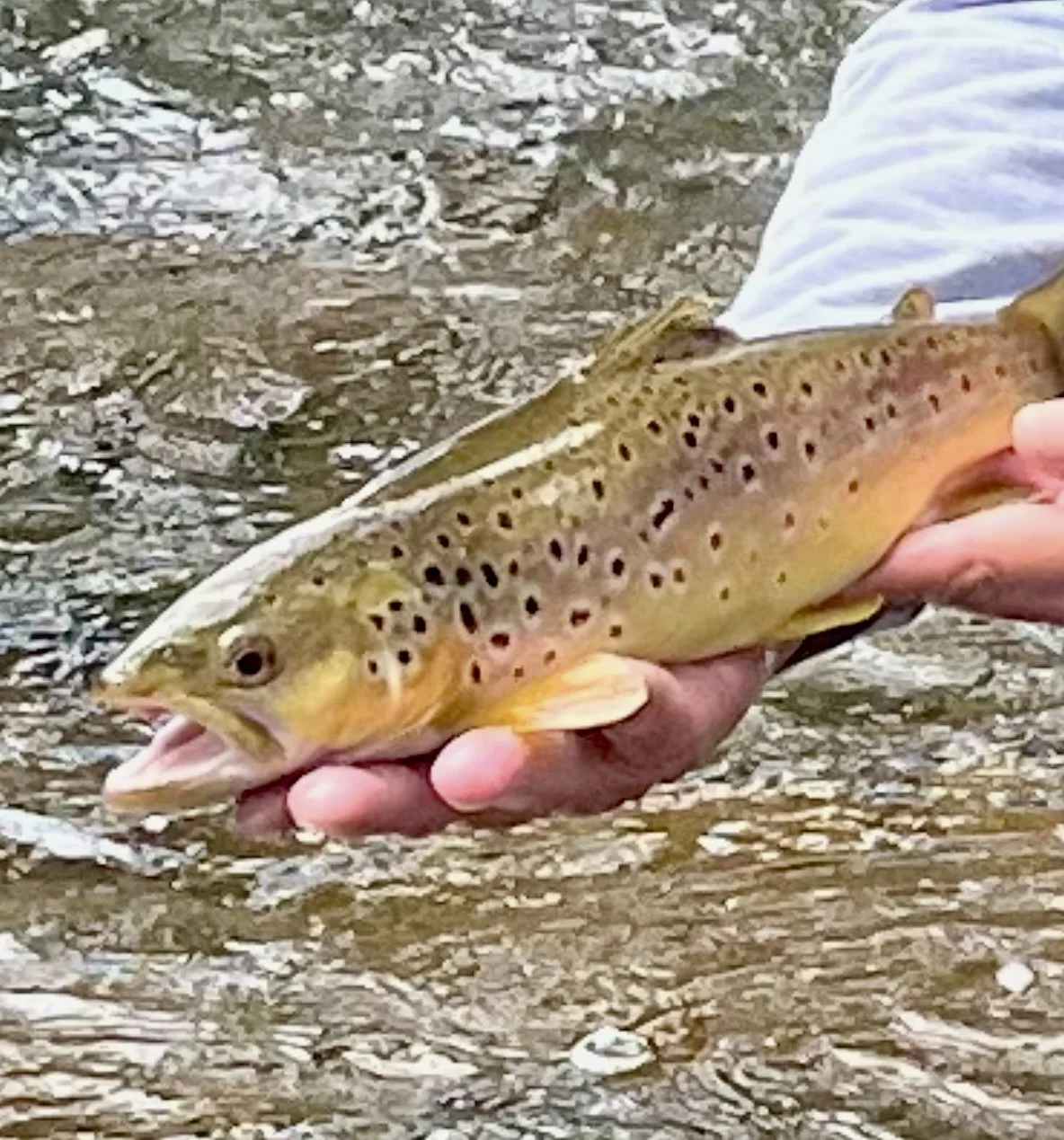Tips for Fishing Skinny water
Generally, most of our wadable trout streams run low and clear from the lack of rainfall this time of year. If you keep your eyes peeled for trout and wade with extra stealth, there’s always a good chance to sneak up and sight-fish both rainbow and brown trout. All things being equal, just because you can see the trout, doesn’t mean they’re always easy to catch. Some days, the trout will make you want to pull your hair out as you painfully watch your flies ignored over and over, as they drift within inches of the trout you’re sight-fishing to. Below are a few tips to help fly anglers catch more shallow water trout while sight-fishing.
Brown Trout - Central Western, NSW
Proper Positioning - When trout are holding in shallow water that’s calm and clear, it can make them extremely difficult to catch because the water conditions allow trout to hear and see very well. One of the biggest mistakes I see on the water by novice fly anglers when they’ve spotted a trout holding in shallow water, is they position themselves too far downstream (from the fish they see and want to cast to) when they make their initial presentation. The smaller the angle one casts to a trout, the more precise and accurate the presentation (angle and distance) needs to be. Too long of a cast, and you’ll risk spooking the trout by lining the fish (laying fly line over the back or too close to the fish) . On the other hand, if you cast at the wrong angle, your flies will often not drift close enough to the feeding trout, and will fail to enter the strike zone.
When I’m sight-fishing to trout in shallow water, I always try to approach the trout from the side as much as I can (I get as perpendicular to the trout as possible) without spooking it. Doing so, it makes it much easier for me to present my flies to the trout with my leader only, not my fly line, and I find that I spook far less fish this way. Furthermore, when I approach the trout from the side, it usually decreases the distance of the cast needed to drift my flies in front of the spotted trout. Shorter presentations also improve my ability to lay out softer presentations, and in most cases, I find it much easier to also maintain a drag-free drift to the fish with my flies, because I don’t have to fight different current seams between me and the trout I’m targeting.
Approach quietly - Just remember, the closer you get to trout, the more risk you have of alerting and spooking them. For anglers to be successful, they should move twice as slow, and take extra precaution to be as quiet as possible when wading into position. I like to take my time getting into position and then wait and observe, even if this takes a minute or so before I make my first presentation. The main purpose is to allow any fish that may have been alerted during the approach to calm down and resume feeding. If you’ve got multiple trout scattered out along a run or pool, sometimes all it takes to ruin your chances at success is spooking one or more of the other fish in the area, which can in turn, alert all of the other fish.
Don’t make repeated presentations - If you want to consistently catch shallow water trout when sight-fishing, you have to maintain some discipline in your fly fishing. For example, if you spot a fish and make one cast after another, over the fish, chances are the fish will eventually get spooked or get lock jaw and won’t eat your fly. I stress to my clients that they should focus on the quality of their presentations not quantity. It’s ok to make a few presentations to a fish, but if you don’t get any interest, you’re usually going to be much better off to give the fish a break for a few minutes before you resume your presentations. Always remember if you’re drifting the fly where you need to and the trout’s not showing any interest, it’s usually that your fly isn’t at the correct depth, it’s not drifting close enough to the trout, or your fly pattern is wrong. Try experimenting in these areas when you’re working a fish and not having luck. Often, by troubleshooting and making adjustments in these areas, you’ll end up catching the trout.
Casting Accuracy - Most of the time, the closer a trout is to the surface, the smaller the feeding lane and strike zone is going to be. This means that anglers have to be super accurate with their presentations if they want to catch shallow water trout. One problem I have with clients is they often lack the ability to make repeated presentations at the same distance. One cast will be spot on, and the next one will be five to ten feet off target. To catch shallow water trout consistently, you need to be able to make repeated casts accurate to less than a foot in distance and angle to your target. One tip I tell my clients is to move in close and pinch the fly line in their rod hand against the cork grip when they make a good presentation. Doing so, it makes it much easier to duplicate the cast over and over when strike zones are only inches across. I can’t end this tip without bringing up the importance of fly line management during the drift.
Many fly anglers believe that line management only deals with managing the slack between your rod tip and your fly during your drift. Properly timed fly line mending, and manipulating the location of your flies during the drift (ex. Making slight adjustments of the fly/flies location or action by: pulling (bringing fly towards you), skating/twitching to add action, raising rod tip or briefly adding a belly in front of flies (to raise your wet flies up over a shallow spot), or adding slack (to sink, improve or extend drag-free drift) during the drift are all very important to get your flies in the strike zone and to trigger trout to eat. This is especially true when you have irregular bottom depths and/or challenging currents to manage from the beginning to the end of your drift.
Pick your time - The other day on the water guiding my client and I spotted several big trout in a shallow, slow moving run. The sun was high and the fish were really spooky. We only managed to get one bite, and the one we got, broke us off shortly after the hook up. We tried for several more minutes to get another one of the trout we’d spotted to bite, but we got the shaft. Rather than continuing to strike out, I recommended we move on and come back when the light conditions were more in our favour. In the afternoon, the sun was not beating down on the water and the entire run was shaded. This time when we fished the spot, the fish seemed more aggressive and less spooky. We ended up landing three fish out of that run that had previously kicked our ass. Make observations about how certain areas of a trout stream fish during different times of the day. Sometimes, all it takes to find success, is fishing spots at the right time of the day, when the light conditions are more favourable.
Keep it Reel.


